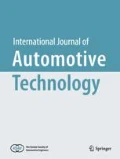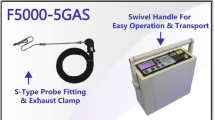Abstract
The vehicular illumination system has undergone considerable technological advances in recent decades such as the use of a Light Emitting Diode (LED) Adaptive Front-lighting System (AFS), which represents an industry breakthrough in lighting technology and is rapidly becoming one of the most important innovative technologies around the world in the lighting community. This paper presents AFS control alternatives using fuzzy logic (types 1 and 2) to determine its operating parameters taking into consideration the road conditions in the state of São Paulo (Brazil). Fuzzy logic is a well-known extension of the conventional (Boolean) logic that enables the treatment of uncertainty present in the information through the definition of intermediary membership values between the “completely true” and the “completely false”. This technique or modeling strategy is particularly important when a multi-parameter decision must be taken or the decisions are based on the human knowledge. The results show the potential of the methodology proposed and its suitability for light control providing safer nighttime driving.
Similar content being viewed by others
Abbreviations
- a 0, a 1 :
-
output model parameters
- Δ :
-
deviation of type-1 interval fuzzy set
- σ :
-
standard deviation of type-1 Gaussian fuzzy set
- y :
-
current to LEDs (mA)
- V :
-
velocity of the vehicle velocity (km/h)
- R :
-
radius of the curve (m)
References
AL (2009). Automotive Lighting Website. http://www.allighting.de.
Altinten, A., Erdgan, S., Hapglu, H. and Alpbaz, M. (2003). Control of a polymerization reactor by fuzzy control method with genetic algorithm. Comput. Chem. Eng., 27, 1031–1040.
Anderson, T., Sawyers, T. and Bell, M, (1998). Optimization of a fuzzy logic traffic signal controller by a multiobjective genetic algorithm. 9th Int. Conf. Road Transport Information and Control, 454, 186–190.
Babuška, R. and Verbruggen, H. B. (1996). An overview of fuzzy modeling for control. Control Eng. Practice, 4, 1593–1606.
Bellman, R. E. and Zadeh, L. A. (1970). Decision-making in a fuzzy environment. Management Science, 17, 141–164.
Chen, B. and Liu, X. (2004). Reliable control design of fuzzy dynamic systems with time-varying delay. Fuzzy Sets and Systems, 146, 349–374.
Du, G.-N. and Zhu, Z.-Y. (2006). Modeling spatial vagueness based on type-2 fuzzy set. J. Zhejiang University SCIENCE A 1, 250–256.
Dubois, D. and Prade, H. (1978). Operations on fuzzy numbers. Int. J. Systems Science, 9, 613–626.
Dubois, D. and Prade, H. (1979). Operations in a fuzzy-valued logic. Information and Control, 43, 224–240.
Ekriasa, A., Eloholma, M., Halonen, L., Song, X., Zhang, X. and Wen, Y. (2008). Road lighting and headlights: Luminance measurements and automobile lighting simulations. Building and Environment, 43, 530–536.
EN (2003). Road Lighting—Part 3: Calculation of Performance. European Standard EN 13201-3, Publication 270-2003, Ref. No. EN 13201-3: 2003 E.
Feng, J., Li, J. and Yu, F. (2003). GA-based PID and fuzzy logic control for active vehicle suspension system. Int. J. Automotive Technology 4,4, 181–191.
Gotoh, S. and Aoki, T. (1996). Development of active headlight. 15th Int. Conf. Enhanced Safety of Vehicles. Melbourne, Australia.
Hagras, H. A. (2004). A hierarchical type-2 fuzzy logic control architecture for autonomous mobile robots. IEEE Trans. Fuzzy Systems, 12, 524–539.
Hamm, M. (2002). Adaptive lighting functions history and future-Performance investigations and field test of user acceptance. SAE Paper No. 2002-01-0526.
Hara, T., Kuramochi, T., Ayama, M., Kojima, S. and Sato, T. (2001). Evaluation of AFS from Driver’s Point of View, Progress in Automobile Lighting. Darmstadt. Germany’ Technical University of Darmstadt. 397–402.
Hisdal, E. (1981). The IF-THEN ELSE statement and interval-values fuzzy sets of higher type. Int. J. Man-Machine Studies, 15, 385–455.
Hogrefe, H. (2000). Adaptive front lighting systems for optimum illumination of curved roads, highway lanes and other driving situations. SAE Paper No. 2000-01-0431.
Ishiguro, K. and Yamada, Y. (2004). Control technology for bending mode AFS. SAE Paper No. 2004-01-0441.
Just Auto (2007). Annual Just-auto’s Review of 2007 — Management Briefing. Just Auto. Aroq Limited. UK.
Karnik, N. N. and Mendel, J. M. (1998). Introduction to type-2 fuzzy logic systems. Fuzzy Systems Proc. IEEE World Cong. Computational Intelligence. The 1998 IEEE Int. Conf., 2, 915–920.
Karnik, N. N. and Mendel, J. M. (2000). Operations on type-2 fuzzy sets. Int. J. Fuzzy Sets and Systems, 1, 327–348.
King, P. J. and Mamdani, E. H. (1977). The application of fuzzy control systems to industrial processes. Automatica, 13, 235–242.
Kosonen, L. (2003). Multi-agent fuzzy signal control based on real-time simulation. World Cong. Intelligent Transport System, October, Transportation Research Part C: Emerging Technologies, 11, 389–403.
Hwang, J. and Song, C. (2005). Fuzzy estimation of vehicle speed using an accelerometer and wheel sensors. Int. J. Automotive Technology 6,4, 359–365.
Hella (2009). Hella website. www.hella.de.
Li, L., Lin, W.-H. and Liu, H. (2006). Type-2 fuzzy logic approach for short-term traffic forecasting. Intelligent Transport Systems, IEEE Proc., 153, 33–40.
Liang, Q. and Mendel, J. M. (2000). Interval type-2 fuzzy logic systems: Theory and design. IEEE Trans. Fuzzy Systems, 8, 535–550.
Löwenau, J. P., Strob, M. H., Bernasch, J. H., Reich, F. M. and Rummel, A. H. (2001). Evaluation of adaptive light control in the BMW driving simulator. Proc. 2001 Driving Simulation Conf., Arcueil, France. INRETS.
Mendel, J. M. (2001). Uncertain Rule-based Fuzzy Logic Systems: Introduction and New Directions. Prentice-Hall. London. UK.
Mendel, J. M. (2003). Fuzzy sets for words: A new beginning. The IEEE Int. Conf. Fuzzy Systems, 37–42.
Mendoza, O., Licea, G. and Melin, P. (2007). Modular neural networks and type-2 fuzzy logic for face recognition. Annual Meeting of the North American Fuzzy Information Processing Society, NAFIPS’ 07, 622–627.
Mizumoto, M. and Tanaka, K. (1976). Some properties of fuzzy sets of type-2. Information and Control, 31, 312–340.
Mizumoto, M. and Tanaka, K. (1981). Fuzzy sets of type-2 under algebraic product and algebraic sum. Fuzzy Sets and Systems, 5, 277–290.
Neumann, R. (2004). AFS halogen headlamp system: Experimental study and first field results. SAE Paper No. 2004-01-0439.
Neumann, R. (2006). LED front lighting — Optical concepts, styling opportunities and consumer expectations. SAE Paper No. 2006-01-0100.
Niittymäki, J. and Turunen, E. (2003). Traffic signal control n similarity logic reasoning. Fuzzy Sets and Systems, 133, 109–131.
Østergaard, J.-J. (1977). Fuzzy logic control of heat exchange process. M. M. Gupta, G. N. Saridis, B. R. Gaines (Eds.). Fuzzy Automata and Decision Process. North-Holland. Amsterdam. 285–320.
Pareek, U. and Kar, I. N. (2006). Estimating compressor discharge pressure of gas turbine power plant using type-2 fuzzy logic systems. IEEE Int. Conf. Fuzzy Systems, 649–654.
Ren, Q., Qin, Z., Baron, L., Birglen, L. and Balazinski, M. (2007). Identification of rigid-body dynamics of robotic manipulators using type-2 fuzzy logic filter. Annual Meeting of the North American Fuzzy Information Processing Society, NAFIPS’ 07, 387–392.
Sala, A., Guerra, T. M. and Babuška, R. (2005). Perspectives of fuzzy systems and control. Fuzzy Sets and Systems, 156, 432–444.
Schmocker, J., Ahuja, S. and Bell, M. (2008). Multiobjective signal control of urban junctions- Framework and a London case study. Transportation Research Part C, 16, 454–470.
Sivak, M., Schoettle, B., Flannagan, M. and Minoda, T. (2005). Optimal strategies for adaptive curve lighting. J. Safety Research, 36, 281–288.
Stern, D. (2008). Global Market Review of Automotive Lighting-Forecasts to 2013, 2008 Edn. Just Auto. Aroq Limited. UK.
Tahayori, H., Tettamanzi, A. G. B. and Degli Antoni, G. (2006). Approximated type-2 fuzzy set operations. IEEE Int. Conf. Fuzzy Systems, 1910–1917.
Thovutikul, S., Auephanwiriyakul, S. and Theera-Umpon, N. (2007). Microcalcification detection in mammograms using interval type-2 fuzzy logic system. IEEE Int. Fuzzy Systems Conf., FUZZ-IEEE 2007, 1–5.
UNECE (2008). UNECE website. http://www.unece.org/trans/main/wp29/wp29regs41-60.html
Wördenweber, B., Wallaschek, J., Boyce, P. and Donald D. Hoffman, D. (2007). Automotive Lighting and Human Vision. Springer Verlag. USA.
Yu, F., Feng, J. and Li, J. (2002). A fuzzy logic controller design for a vehicle ABS with a on-line optimized target wheel slip ratio. Int. J. Automotive Technology 3,4, 165–170.
Zadeh, L. A. (1975). The concept of a linguistic variable and its application to approximate reasoning — 1, Information Sciences, 8, 199–249.
Zukauskas, A., Shur, M. and Caska, R. (2002). Introduction to Solid-State Lighting. Wiley Interscience. USA.
Author information
Authors and Affiliations
Corresponding author
Rights and permissions
About this article
Cite this article
Lukacs, L., Dassanayake, M., Magalhaes, R. et al. Benefits and challenges of controlling a LED AFS (adaptive front-lighting system) using fuzzy logic. Int.J Automot. Technol. 12, 579–588 (2011). https://doi.org/10.1007/s12239-011-0068-y
Received:
Revised:
Published:
Issue Date:
DOI: https://doi.org/10.1007/s12239-011-0068-y




